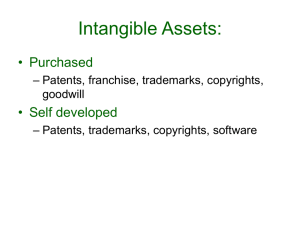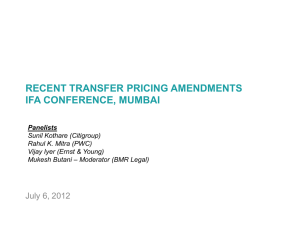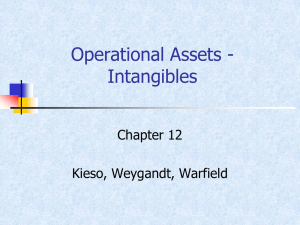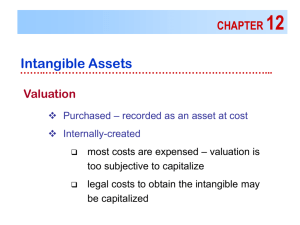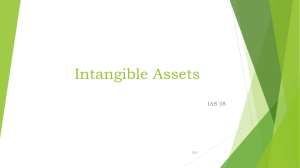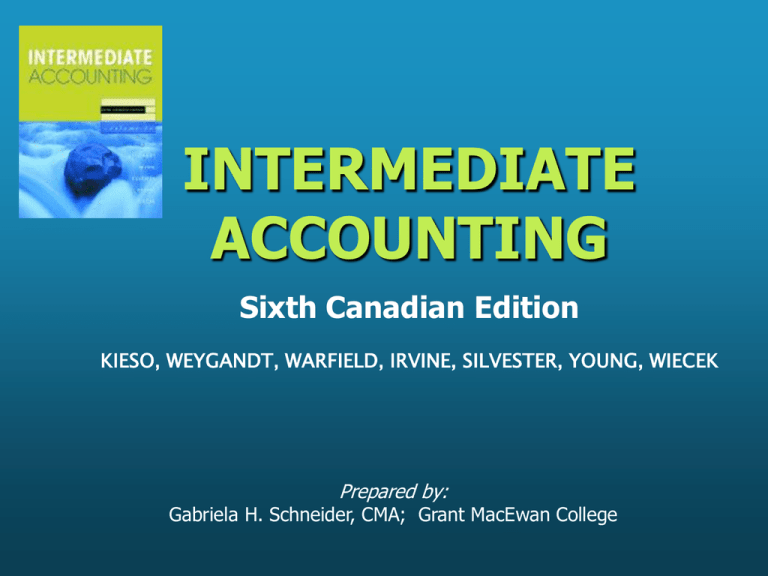
INTERMEDIATE
ACCOUNTING
Sixth Canadian Edition
KIESO, WEYGANDT, WARFIELD, IRVINE, SILVESTER, YOUNG, WIECEK
Prepared by:
Gabriela H. Schneider, CMA; Grant MacEwan College
CHAPTER
13
Intangible Assets
Learning Objectives
1. Describe the characteristics of intangible assets.
2. Discuss the recognition and measurement
issues of acquiring intangibles.
3. Explain how specifically identifiable intangibles
are valued subsequent to acquisition.
4. Identify the types of specifically identifiable
intangible assets.
5. Explain the conceptual issues related to
goodwill.
Learning Objectives
6. Describe the accounting procedures for recording
goodwill at acquisition and subsequently.
7. Differentiate between research and development
expenditures and describe and explain the
rationale for the accounting for each.
8. Identify other examples of deferred charges and
the accounting requirements for them.
9. Identify the disclosure requirements for
intangibles, including deferred charges.
Intangible Assets
Intangible Asset Specifically
Issues
Identifiable
Intangibles
Goodwill
Characteristics
Patents
Recognition
Current
standards
Copyrights
Negative
Goodwill
Trademarks
Recognition and
Leaseholds
measurement at
Franchises
acquisition
Valuation after
acquisition
Intellectual Deferred Charges
Financial
Capital
and Long-term
Statement
Prepayments
Disclosure and
Presentation
Valuation after
acquisition
Impairment
Balance Sheet
Research and
development
Income
costs
Statement
Pre-operating
Illustrative
costs
disclosures
Initial operating
losses
Organization costs
Advertising costs
Conceptual
questions
Intangibles: Characteristics
CICA Handbook, Section 3062, broadly
•
defines intangible assets as:
lacking physical existence
non-financial assets
•
•
•
Characteristics include:
identifiability
2. manner of acquisition
3. expected period of benefit
4. separability from an entire enterprise
1.
Recognition and Measurement
Purchased Intangibles
• Measured at cost – fair value at acquisition
• Cost follows same definition as with tangible capital
assets
• Purchase of identifiable intangibles is generally
straightforward
– Value is more easily determined
• Business combinations leads to goodwill
• Goodwill: (as an example)
– does not generate easily identifiable cash flows
– is not readily separable from the business entity
– control does not lead to contractual or legal rights
• Value (cost) of goodwill becomes a residual amount
Recognition and
Measurement
• Goodwill should be accounted for and
reported separately from other
intangibles
• Identifiable intangibles with similar
characteristics should be grouped and
reported together
• Subsequent costs (betterments) are
capitalized
Valuation of Intangible
Assets
Intangibles
InternallyCreated
Purchased
Specifically
Identifiable
Goodwilltype assets
Deferred
Charges
Specifically
Identifiable
Capitalize
Capitalize
Capitalize
Restricted
Amounts
Expense,
except direct
costs
Goodwill
type assets
Expense
Valuation after Acquisition
• Intangibles are written-off over their useful
lives, where the assets have determinable useful
lives, not exceeding 40 years
• Where the intangibles have indeterminable
useful lives, they must be written-off over a
period not exceeding 40 years
• If the intangibles have an indefinite infinite life,
the asset remains in the accounts unless it
becomes impaired or its life becomes finite
• Intangibles are considered to have no residual
(salvage) value
Valuation after Acquisition
•
Factors to consider when determining
economic useful life of an intangible:
1. Expected future usage
2. Effects of technological or commercial
obsolescence
3. Level of maintenance expenditures required to
obtain future benefits
•
Method of amortization should be chosen to
match the benefits received, otherwise,
straight-line amortization is used
Specific Intangibles: Types
•
Patents
–
•
Copyrights
–
•
•
relating to creations of authors, painters,
musicians and artists
Trademarks and Trade Names
Leaseholds
–
•
product patents and process patents
Lease Prepayments, Leasehold Improvements and
Capital Leases
Franchises and Licenses
Patents
• A patent gives an exclusive right to the holder
for 20 years
• Costs of purchasing patents are capitalized
• Costs to research and develop patents are
expensed as incurred
• Patents are amortized over the shorter of the
legal life (20 years) or their useful lives
– Normally amortized over 17 years
– First 3 years required to process a patent application
Copyrights
• Copyrights are granted for life of the creator,
plus 50 years
• Copyrights can be sold or assigned, but can
not be renewed
• Copyrights are amortized over their useful life
(not to exceed 40 years)
• Costs of acquiring copyrights are capitalized
• Research and development costs involved are
expenses as incurred
Trademarks and
Trade Names
• Trademarks and trade names are renewable
indefinitely by the original user in periods of
20 years each
• For accounting purposes, trademarks and
trade names are amortized over periods not
exceeding 40 years
• Costs of acquired trademarks or trade names
are capitalized
• If trademarks or trade names are developed
by the business, all direct costs (except R&D
costs) are capitalized
Leaseholds
• A leasehold is a contractual agreement
Details:
– agreement between the lessor (owner) and
the lessee (renter)
– gives the lessee the right to use the
property
– valid for a specific period of time
– in return for stipulated, periodic cash
payments
Leaseholds and Leasehold
Improvements
• Lease prepayments are to be shown as
prepaid expenses, not as intangible assets
• Leasehold improvements (made by the lessee)
revert to the lessor at end of lease term
• Leasehold improvements are amortized over
the shorter of the remaining term of the lease
or useful life of the improvements
• Leasehold improvements are generally shown
in the (tangible) property, plant, and
equipment section
Leases (Capital Leases)
• If the lease agreement transfers all
benefits and risks, the lease is classified
as a capital lease
• The lease is shown as a tangible asset
(at the capitalizable cost), rather than
as an intangible asset
Franchises and Licenses
• A franchise is a contractual agreement
under which the franchisor grants the
franchisee the right to:
– sell certain products or services
– use certain trademarks or trade names
– perform certain functions within a certain
geographical area
Franchises and Licenses
• A franchise may exist for a limited time or for
an indefinite time period
• The cost of a franchise (for a limited time), is
amortized over the franchise term
• A franchise (for an unlimited time), is
amortized over a period not exceeding 40 years
• If a franchise is deemed worthless, the cost
must be written-off immediately
• Annual payments for a franchise are expensed
Goodwill
• Goodwill: the excess of the cost (purchase
price) over the amounts (price) assigned to
tangible and intangible net assets
• Goodwill is the most intangible of all
assets
• Goodwill can be sold only with the
business
Acquired Goodwill: Valuation
Given:
Purchase price (cash):
Book value of assets:
Liabilities:
Market value of assets:
Determine goodwill.
$
$
$
$
400,000
255,000
55,000
350,000
Acquired Goodwill:
Calculation
Goodwill = Purchase Price - Fair value of net assets
$400,000 less 350,000 = $50,000
Entry in the books of the Purchaser:
Assets (various) 405,000
Goodwill
50,000
Liabilities
55,000
Cash
400,000
Negative Goodwill
• “Badwill” or bargain purchase
– Fair value of acquired assets is greater than the
purchase price
• CICA Handbook, Section 1581
– Excess is used to reduce the amounts assigned to
the other acquired assets, except for:
•
•
•
•
financial assets (other than equity method investments)
assets to be sold
future tax assets
prepaid assets that relate to employee future benefit plans
– If any excess remains after such assignment,
remainder treated as an extraordinary gain
Intellectual Capital
• Also known as knowledge assets
• Include (among others), the following:
–
–
–
–
Value of key personnel
Organization adaptability
Customer retention
Strategic direction
• Conceptually cannot be reported as assets as
the company does not have control
• They do, however, create long-term value
(and benefit) to the company
Deferred Charges and
Long-term Prepayments
• Research and Development Costs (R&D)
• Pre-operating and start-up costs
• Organization costs
• CICA Handbook, Section 3070 requires
separate disclosure of deferred charges
and their amortization amounts
Research and Development
(R&D) Costs
• R&D costs not in themselves intangible assets
• They are generally material in amount, and lead to
something that will be patented or copyrighted
• They therefore warrant special consideration
• Challenges in R&D accounting:
• Determining the costs associated with a particular activity or
project
• Determining the size of future benefits, and for how long those
benefits may be realized
• CICA Handbook, Section 3450 governs the accounting of
R&D costs
• All research costs charged to expense when incurred
• Development costs are charged to expense except in certain
defined circumstances
Research and Development
(R&D) Costs
• Research activities:
• involve planned search or critical investigation
aimed at discovery of new knowledge
• may or may not be directed towards a specific
project
• Development activities include:
• translation of research findings or other
knowledge into a plan or design for a new product
or process
• significant improvement to an existing product or
process
Research and Development
(R&D) Costs
•
R&D costs include the following:
1. Direct materials and direct labour
2. Amortization of tangible and intangible assets
used/related to R&D activities
3. Reasonable overhead allocation
•
•
R&D costs are expensed
Development costs are capitalized when all
five of the following conditions are met and
future benefits are reasonably certain
Research and Development
(R&D) Costs
Development cost capitalization criteria:
1. Product/process clearly defined, and costs
can be identified
2. Technical feasibility has been established
3. Management intent to produce and market
or use the product/process
4. If the intent is to sell, a market is clearly
defined. If the intent is to use, there is a
definable use/need
5. Resources exist to complete the project
Pre-operating Costs
•
Costs incurred prior to formal operations
beginning
•
EIC-27 allows for the deferral of pre-
operating costs if three conditions are met:
1. The expenditure relates directly to the business
2. It would not have been incurred if not for the
business
3. The amount is likely to be recovered from future
operations
Financial Statement
Disclosure and Presentation
• Balance Sheet
– Goodwill must be reported as a separate
line item
• Income Statement
– Amortization methods and rates are
disclosed
– Goodwill impairment loss is reported
separately
COPYRIGHT
Copyright © 2002 John Wiley & Sons Canada, Ltd.
All rights reserved. Reproduction or translation of
this work beyond that permitted by CANCOPY
(Canadian Reprography Collective) is unlawful.
Request for further information should be
addressed to the Permissions Department, John
Wiley & Sons Canada, Ltd. The purchaser may
make back-up copies for his / her own use only and
not for distribution or resale. The author and the
publisher assume no responsibility for errors,
omissions, or damages, caused by the use of these
programs or from the use of the information
contained herein.

